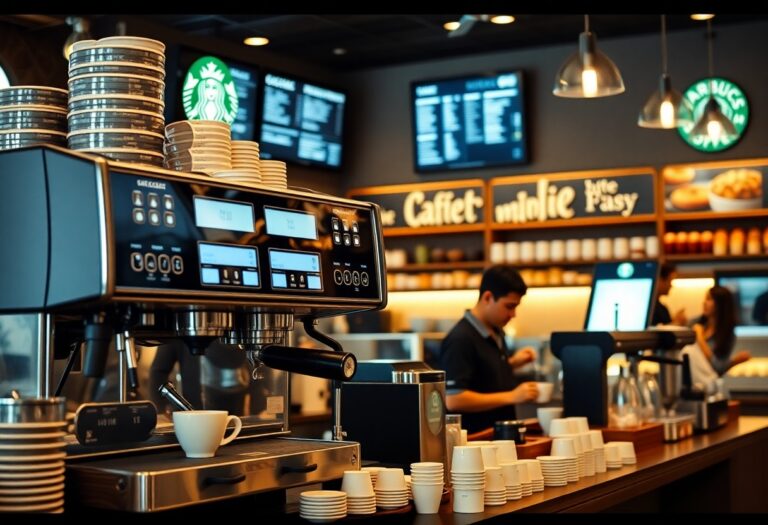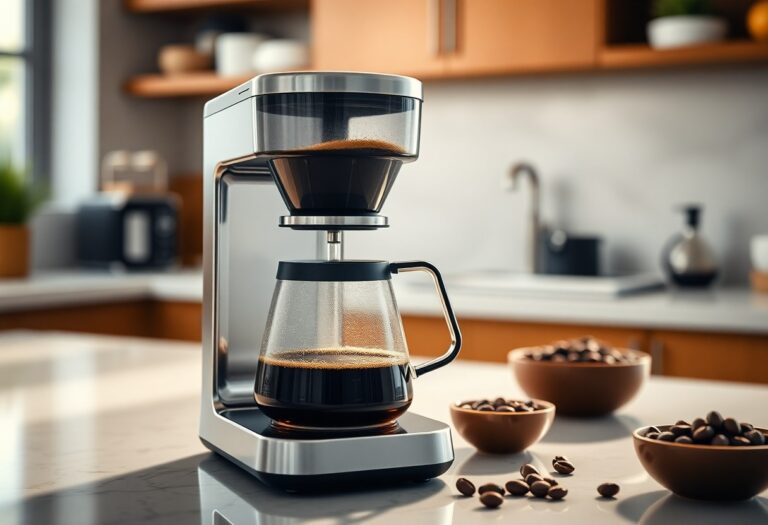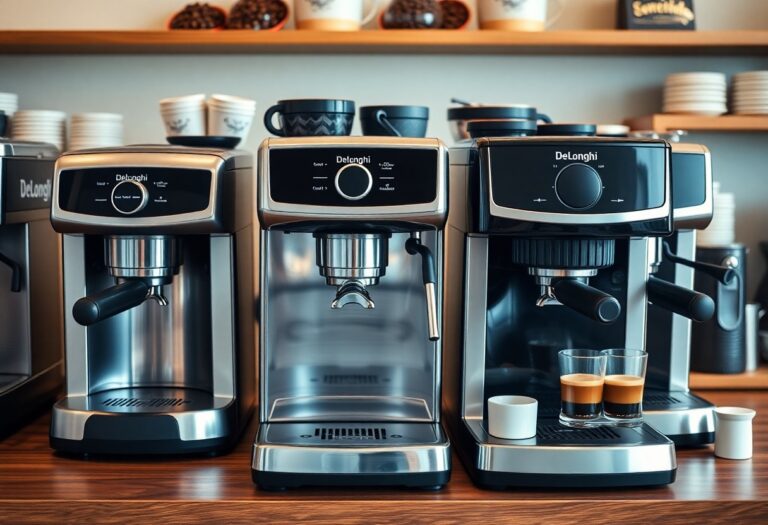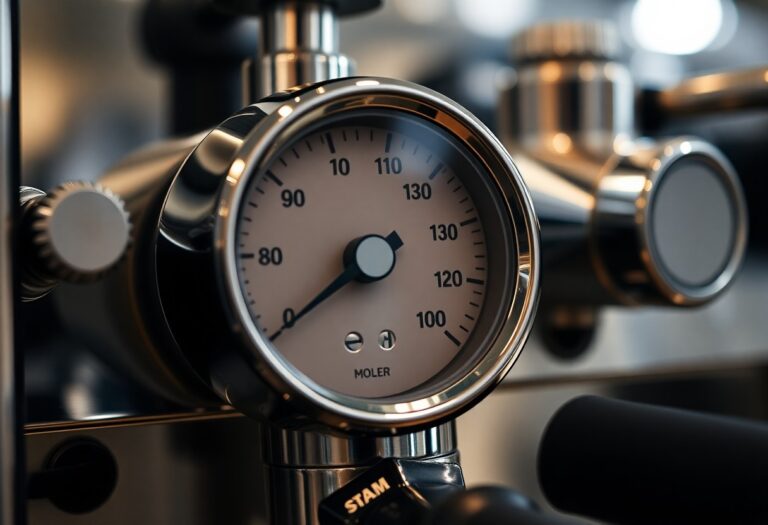What Coffee Grounds to Use for an Espresso Machine – Grind Guide
Most espresso enthusiasts understand that using the right coffee grounds can make or break your brewing experience. In this guide, you will discover the best grind size for your espresso machine, ensuring you extract the rich flavors and aromas that define a perfect shot. You’ll learn how different coffee beans impact your espresso, enabling you to tailor your brew to your preferences. Dive in to elevate your coffee game and make every cup a memorable one!
Key Takeaways:
- Espresso typically requires a finer grind, which helps to extract bold flavors and create the signature crema.
- Using freshly ground coffee beans ensures optimal flavor and aroma when brewing espresso.
- Experiment with different coffee bean varieties, as they can significantly impact the taste profile of your espresso.
- Pay attention to grind size adjustments based on your specific espresso machine, as different machines may require slight variations.
- Choose coffee that is specifically labeled for espresso to ensure the best compatibility and results.

The Unsung Hero: Coffee Bean Selection
Your choice of coffee beans can greatly influence the espresso experience, as it serves as the foundation of flavor in every brew. Selecting the right beans goes beyond what’s popular; it’s about knowing which beans will deliver the richness and depth that espresso demands. A skilled barista focuses on quality beans, considering factors like roast level and freshness, which play a pivotal role in achieving a remarkable cup. Whether you enjoy fruity notes or deep, chocolatey undertones, the selection you make will set the stage for your espresso masterpiece.
Varietals That Thrive in Espresso
Some coffee varietals naturally excel when brewed as espresso, particularly those with a balance of acidity and sweetness. For instance, Arabica beans, especially those sourced from Ethiopia and Colombia, deliver a vibrant, nuanced flavor profile that enhances espresso. Additionally, robusta beans, while often considered inferior, can contribute a rich crema and a fuller body, making them a favorite in certain blends. Look for blends that incorporate both varietals to achieve a harmonious balance in your cup.
The Impact of Origin on Flavor Profiles
The geographical origin of coffee beans significantly shapes their flavor profile, resulting in distinct characteristics that are often tied to specific regions. For example, beans from Central America tend to showcase bright acidity and fruity overtones, while those from South America are renowned for their smooth, chocolate-like qualities. In contrast, African beans often exhibit floral notes and vibrant citrus flavors. Each region’s unique climate, altitude, and soil composition contribute to the beans’ signature taste, allowing you to craft an espresso that reflects the nuances of its origin.
Grind Size Matters: The Science Behind Espresso
The grind size you choose for espresso significantly influences the flavor and quality of your brew. A finer grind allows water to extract soluble compounds in the coffee more efficiently, leading to richer flavors and optimal crema. If you want to research deeper into this science, check out the Coffee Grind Size Chart: Find the Answers Here!.
What Makes Espresso Grind Unique?
Espresso grind is characterized by its ultrafine consistency, akin to powdered sugar. This unique texture facilitates rapid extraction during the short brewing time of espresso, usually around 25-30 seconds. The grind size must be balanced to prevent over-extraction, which can result in unwanted bitterness, or under-extraction, leading to sourness.
The Role of Consistency in Extraction
Consistency in grind size is vital for achieving uniform extraction in espresso brewing. When the coffee grounds vary in size, water flows unevenly, resulting in some particles being over-extracted while others remain under-extracted. This imbalance can affect the bitterness and flavor profile of your shot drastically. By ensuring that all your grounds are uniform, you optimize the flavor extraction process, resulting in a smooth, well-balanced cup.
In espresso brewing, using a burr grinder can significantly improve grind consistency. A quality burr grinder not only delivers uniform particles but also allows you to make precise adjustments. When every part of your coffee grounds is similar in size, the water interacts evenly with each particle, creating a balanced taste in your espresso. Striving for this consistency is one of the hallmarks of a skilled barista, enhancing every shot you pull.

The Art of Calibration: Dialing In Your Grind
Calibration transforms your coffee experience, guiding you to achieve that perfect extraction. Every espresso machine and coffee blend has unique requirements, making it crucial to regularly adjust your grind size. Too coarse, and you risk over-extraction leading to bitterness; too fine may cause under-extraction resulting in a sour taste. You’ll find that the ideal grind can be influenced by the bean origin, roast level, and even humidity on a given day, so stay attentive to your shots.
Techniques for Adjusting Grind Size
To adjust your grind size effectively, practice small increments. Start by changing your grind by a few notches on your grinder, watching the extraction time and flavors closely. Techniques like the “one-second rule”—altering your grind by adjusting the time you grind for just one second—can yield noticeable results. Testing with a consistent coffee dose and brewing time helps ensure your calibrations are on point, giving you a controlled way to explore how the grind impacts your espresso.
Common Indicators of an Incorrect Grind
Identifying an incorrect grind becomes apparent through tasting and observing your espresso. If your shot flows in less than 20 seconds or more than 30 seconds, it signals a problem with the grind size. Additionally, an unbalanced flavor profile, such as overwhelming bitterness or unexpected sour notes, can denote under or over-extraction due to grind miscalibration. Keep an eye on your espresso’s crema; a thin, pale crema suggests a grind that’s too coarse, while a thick, dark crema with excessive bitterness usually points to a grind that’s too fine.
When you encounter issues like a watery consistency or overly pungent flavors, these often signal grind-related problems. A shot pulling too quickly results in weak espresso, lacking the richness and body you desire. Conversely, long extraction times can lead to bitter profiles, masking the coffee’s natural sweetness. Rely on your palate and visuals throughout the brewing process to inform your adjustments, giving you insight into how your grind impacts extraction and resulting flavors.
Coffee Freshness: The Secret Ingredient
To truly elevate your espresso, the freshness of your coffee grounds plays a vital role. Freshly roasted beans burst with flavor, aromas, and important oils that gradually diminish as they age. For tips on selecting high-quality beans for your espresso machine, check out this insightful guide on What Coffee To Use For Espresso Machines.
Why Freshly Ground is Best for Espresso
Freshly ground coffee delivers optimal flavors and aromas that pre-ground coffee simply can’t match. As soon as coffee beans are ground, they begin to oxidize, losing important oils and flavor compounds. Grinding your coffee beans right before brewing ensures that you’re capturing the maximum essence of your chosen beans, creating a vibrant and aromatic shot of espresso that will tantalize your taste buds.
How to Store Coffee Beans for Optimal Freshness
Proper storage of your coffee beans is critical to maintaining their freshness. Keep your beans in an airtight container in a cool, dark place to slow down oxidation. Avoid exposing them to light, moisture, and heat, as these elements can hasten staleness. For best results, try to utilize the beans within a month of roasting, as their peak freshness diminishes over time, allowing you to enjoy the full spectrum of flavors and aromas.
Using a dark-colored, vacuum-sealed container can significantly enhance your coffee bean storage. These containers shield your beans from harmful light while also preventing moisture infiltration. Consider designating your chosen container for specific types of beans—this helps avoid cross-contamination of flavors. If you buy coffee in bulk, consider freezing a portion, ensuring you use an airtight bag to protect against freezer odors. This way, you can enjoy fresh espresso whenever the craving strikes.
Going Beyond Basics: Specialty Grinds and Techniques
Exploring specialty grinds opens up a world of flavors and nuances for your espresso. By experimenting with different grind sizes, blends, and processing methods, you can uncover unique flavor profiles that elevate your coffee experience. Innovative techniques like pre-infusion and multi-stage extraction can further enhance your brew, allowing subtle notes to shine through, transforming an ordinary shot into an extraordinary one.
Understanding the Role of Tamping and Brew Time
Tamping is an necessary step in espresso preparation; the right pressure not only compresses the coffee grounds but also influences water flow during extraction. A consistent tamping pressure of around 30 pounds is often recommended. Similarly, your brew time is integral to achieving balance; approximately 25-30 seconds is ideal for optimal extraction, ensuring you capture the rich flavors of the coffee.
The Influence of Water Temperature and Quality
Water temperature and quality can make a harmonious or disruptive impact on your espresso shot. The optimal brewing temperature typically ranges from 195°F to 205°F. Using filtered water helps maintain the integrity of your flavors; minerals in tap water, for instance, may either enhance or hinder taste. Therefore, a balance in both temperature and quality can dictate whether your brew is vibrant or dull.
| Aspect | Recommendation |
| Water Temperature | 195°F – 205°F |
| Water Quality | Filtered water is preferable |
Utilizing proper water temperature and quality is not just about aesthetics; it directly influences extraction efficiency and flavor clarity. Water that is too hot can lead to bitter, over-extracted shots, while cooler temperatures can cause under-extraction, resulting in sour or bland taste profiles. Ensuring that you have quality water with appropriate mineral content not only enhances your espresso’s flavor but can also improve the lifespan of your machine by minimizing mineral buildup.
| Water Type | Effect on Flavor |
| Filtered Water | Clean, vibrant flavors |
| Tap Water | Potentially compromised taste |
To wrap up
Drawing together the imperative aspects of coffee grounds for your espresso machine, it’s vital to focus on the grind size, bean quality, and freshness. Opt for a fine grind from high-quality, freshly roasted beans to achieve that rich espresso flavor you desire. By understanding the impact of each element, you can take your espresso-making skills to the next level, ensuring each cup is a delightful experience. Embrace this guide as your tool for perfectly brewed espresso every time, tailored specifically to your preferences.
FAQ
Q: What type of coffee beans are best for using with an espresso machine?
A: The best coffee beans for espresso are typically Arabica and Robusta varieties. Arabica beans tend to have more complex flavors and acidity, while Robusta beans offer more body and a thicker crema. A blend of both can also be effective, providing a balance of flavor and strength.
Q: What grind size should I use for my espresso machine?
A: For espresso, you should use a fine grind size, often compared to the texture of table salt or slightly coarser than powdered sugar. This allows for adequate extraction of flavors within the short brewing time of 25-30 seconds.
Q: How can I tell if my coffee grind is too fine or too coarse for espresso?
A: If your coffee grind is too fine, you may experience a bitter taste and over-extraction during brewing. If it’s too coarse, your espresso may taste sour or weak due to under-extraction. A good practice is to adjust grind size in small increments and taste test until you find the right balance for your palate.
Q: Should I use a coffee grinder or pre-ground coffee for my espresso?
A: Using a burr grinder to freshly grind your coffee beans just before brewing is highly recommended for the best flavor. Freshly ground coffee retains more oils and aromas, resulting in a richer and more flavorful espresso compared to pre-ground coffee which can lose its freshness quickly.
Q: How much coffee should I use for a single or double espresso shot?
A: For a single shot of espresso, you typically need about 7-9 grams of coffee grounds, while for a double shot, 14-18 grams is ideal. It’s important to use a scale for accurate measurement to ensure the right strength and flavor profile for your espresso.







